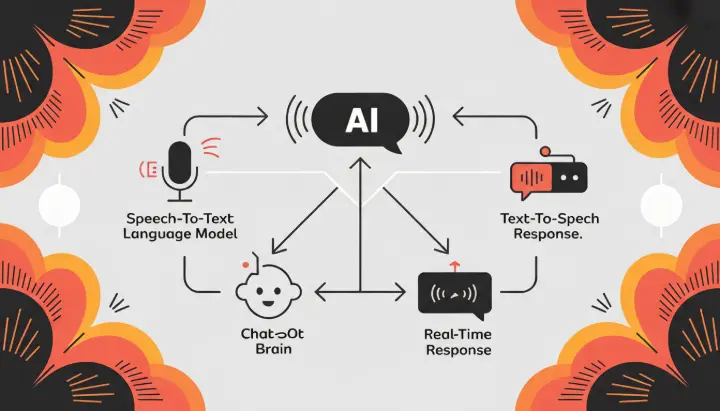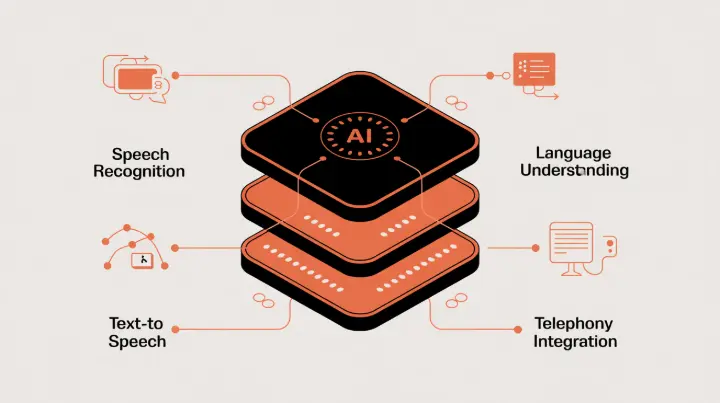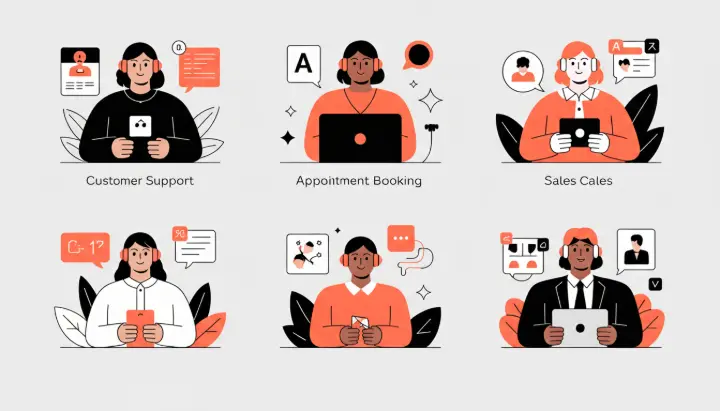What if your next customer support call wasn't handled by a person, but you couldn't tell the difference?
AI calling agents are no longer science fiction. They listen, understand, respond naturally, and even adapt their tone. Businesses are replacing phone queues and robotic IVRs with something smarter: AI voice agents that can actually hold a conversation.
Let's look at how they actually work and what it takes to build one.
What Is an AI Calling Agent?
An AI calling agent is a voice-based AI system that can make or receive phone calls, understand speech, and respond in real time using natural language. Think of it as ChatGPT on a phone call.
These agents are powered by speech-to-text engines, language models like GPT-4o or Claude, and text-to-speech technology. They work 24/7, answering questions, booking appointments, collecting feedback, or handling support without ever needing a break.
How AI Calling Agents Work: A Step-by-Step Breakdown
Behind every natural-sounding AI phone conversation is a sophisticated pipeline of technologies working together in milliseconds. Here's how these intelligent systems transform spoken words into meaningful dialogue.
Speech Recognition (STT)
When a caller speaks, their voice is captured and converted to text in real time. Tools like OpenAI Whisper, Deepgram, or AssemblyAI handle this conversion. Accuracy is critical here, especially when dealing with different accents, background noise, or varying tones. The better the speech recognition, the smoother the conversation flows.
Natural Language Understanding (LLM)
Once the speech is transcribed into text, it's sent to a language model such as GPT-4o, Claude, or Gemini. The model analyzes the text to understand the caller's intent, detect emotional cues, and decide on the best response. It can also query external databases like CRMs, booking systems, or inventory management tools to provide accurate, context-aware answers.
Response Generation
The language model crafts a natural-sounding reply, just like a human would in conversation. This response is designed to be contextually appropriate, empathetic when needed, and informative. The generated text is then passed to the text-to-speech engine for vocalization.
Text-to-Speech (TTS)
The response text is converted back into realistic, human-like speech. Modern TTS engines like OpenAI Realtime API, ElevenLabs Voice API, or Azure Neural Voices can produce voices with tone control, natural pauses, and emotional inflection. This makes the AI sound less robotic and more conversational.

Call Handling Layer (Telephony Integration)
This layer connects the AI with actual phone networks. Services like Twilio, Vocode, or Daily allow the AI to make or receive calls seamlessly.
The telephony layer manages call initiation and termination, speaker detection, and handles interruptions when users speak over the AI or ask it to repeat something.
Memory and Context Management
Great AI calling agents remember previous interactions. They store conversation history to recognize returning callers, track issues or preferences, and adapt responses based on past data.
This memory layer, often powered by tools like Redis or integrated CRM systems, enables true personalization and makes each call feel more human.
The Tech Stack Behind AI Calling Agents
Building an AI calling agent requires several components working together:
For speech-to-text, developers typically use OpenAI Whisper, Deepgram, or Google Speech. The language understanding layer relies on advanced models like GPT-4o, Claude 3.5, Gemini 1.5 Pro, or Llama 3. Text-to-speech is handled by ElevenLabs, OpenAI Realtime, or Azure Cognitive Services.
The telephony and real-time voice connection uses platforms like Twilio, Vocode, Daily, or WebRTC.
The backend orchestration typically runs on Python with FastAPI, Node.js, or frameworks like LangChain and CrewAI. For memory and personalization, systems use Redis, Milvus, Chroma, or direct CRM integrations.
Real-World Applications
AI calling agents are transforming multiple industries. In customer support, they handle basic queries and triage complex issues to human agents. Sales teams use them for lead qualification and automatic follow-ups.
Healthcare providers deploy them for appointment confirmations and prescription updates.

These agents excel at appointment booking, working around the clock to schedule or confirm meetings.
They're also used for feedback collection, calling customers for post-purchase surveys, and even for debt collection and payment reminders, delivering messages with appropriate empathy and politeness.
Challenges in Building AI Calling Agents
Creating an effective AI calling agent isn't without obstacles. Latency is perhaps the biggest challenge. Real-time responses must happen in under 500 milliseconds to maintain natural conversation flow. Any longer, and the interaction feels awkward.
Emotion and tone present another hurdle. The AI must sound empathetic and natural, not robotic or scripted. Handling interruptions gracefully when users speak over the AI requires sophisticated turn-taking logic.
Context retention across multiple sessions can be complex, especially for long-term customer relationships. There are also compliance considerations around recording calls and obtaining consent, particularly under regulations like GDPR and HIPAA.
Finally, cost optimization matters because continuous real-time streaming models can become expensive at scale.
The Future of Voice AI
The gap between human and AI voice interaction is shrinking rapidly. Models like GPT-4o and Claude's emerging capabilities are pushing boundaries every day.
Soon, these agents will detect emotion through intonation analysis, automatically switch languages or adjust their tone based on the situation, and handle multimodal inputs combining voice, images, and data. Deep integration with CRM, HR, and financial systems will allow them to execute complex workflows autonomously.

We're moving toward a world with personalized AI receptionists and agentic voice assistants that can run entire business processes independently.
Conclusion
The next generation of AI isn't just typing replies. It's talking to you, understanding you, and responding in ways that feel genuinely human.
Building an AI calling agent combines the power of language models, speech synthesis, and real-time APIs into one seamless experience. It's not about replacing people. It's about scaling human conversation, making quality interactions available 24/7, and freeing humans to focus on complex, high-value work that truly requires the human touch.
Voice automation is here, and it's more natural than ever before.